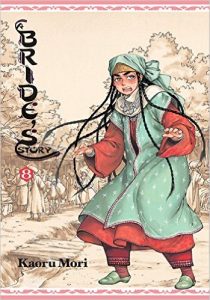By Kaoru Mori. Released in Japan as “Otoyomegatari” by Enterbrain, serialization ongoing in the magazine Harta. Released in North America by Yen Press. Translated by William Flanagan.
After two volumes of focus on Pariya, returning to our home base couple feels very peaceful and reassuring, even if they’re not together a lot of the time. As with the previous volumes, Amir and Karluk’s story is about waiting for Karluk to get older and more mature, and the fact that they love each other regardless. Karluk is a typical teenage boy, even on the Silk Road, and therefore constantly worries that he’s not manly enough and that Amir is somehow unhappy. This is fairly ridiculous, not only because Karluk is nice and sweet and doing his best, but also because Amir is a saint who can do no wrong. (I’ve come to really love A Bride’s Story, but Amir still needs a few more flaws.) But Karkuk doesn’t see this, and so there’s only one thing for a boy on the verge of manhood to do… hunt wild animals! Good thing too, as in this day and in this place, hunting animals for food is a life or death situation.
This also allows Karluk to bond with his brother-in-law, and realize that Amir’s tribe is really in dire straits… they are poor and have very little future available to them. This is presented very matter of factly, and Karluk (and the reader) can’t really do much about it except stare into the middle distance. But at least they’re training Karluk as a hunter, and we get some gorgeous shots of the landscape and foxes, antelope, etc. that roam wild and free but also provide food and clothing for our heroes. Amir shows up every once in a while as well, though Karluk tries to make the visits less frequent, because he’s hoping this will make them long for each other even more. (Amir doesn’t quite get this, of course, because she’s fully accepted her feelings for Karluk already.) He’s a good kid, and I wonder how long it will be before they take that next step.
After their story, we are back to Mr. Smith and his guide, who are finally making their way to Ankara, where he meets up with a good friend he knew from school (and I think his name is Henry? God knows, everyone keeps calling him Smith regardless). That’s not all that follows him, however… Talas, the girl he had the not-quite-romance with several volumes ago, has gotten married but still longs for her true love, and so her husband (whose sainthood here rivals Amir) takes her to Ankara to find Mr. Smith, because he wants her to be happy. I’m not really sure I enjoyed this part as much as the author wanted me to. The story of Smith and Talas was a nice bittersweet tale of a love that wasn’t meant to be, and seeing it revived here feels a bit like a cop out. I suspect their story will take up much of the next volume.
A Bride’s Story has a few weaknesses that my head just can’t get away from, but that doesn’t mean I don’t enjoy the series and its characters. And its art, which is fantastic. Still recommended.



